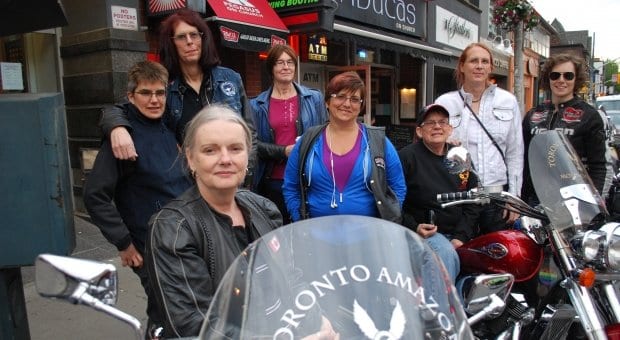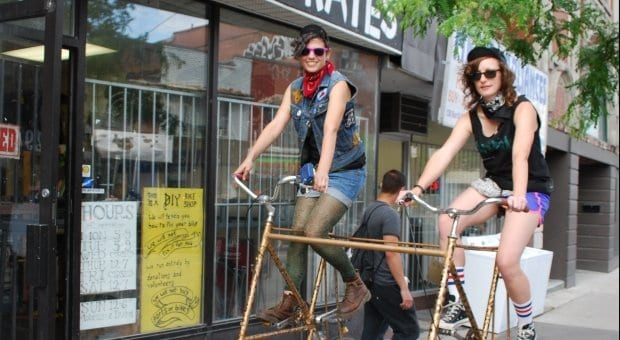
The Toronto Amazons out on Church Street for their weekly social night in the Village. Credit: Andrea Houston
A new group of fierce femmes on two wheels will be at the front of the 2013 Toronto Pride Dyke March. Meet the dykes on bicycles.
Christy Shapley and Susie Jones, who both work at Bike Pirates, will be riding The Social Tandem, a gold animal-print masterpiece that allows two friends to ride side-by-side, towering over the road. They are also organizing a contingent of queer women and allies on bicycles to walk or ride in the march.
Traditionally, the Amazons – Toronto’s gang of “badass bitches” on bikes (as in hogs) – have led the march.
Dyke March team lead Laura Krahn says the Amazons aren’t going anywhere. The lineup for the march has not been finalized, but for safety reasons, she says, the motorcycles must remain at the front, otherwise the bikes will stall.
Bike activism is near and dear to urban queers, she says. In recent years, queer people have been vocal advocates in campaigns against the city, such as the fight for the Jarvis Street bike lanes in 2011.
“Queer people and biking, these issues all go together,” Shapley says. “We want bike infrastructure. We want things that are better for the environment. We want to be safe and happy. And we want a supportive government that cares about the city.”
“This is a lifestyle that is not going away. Cycling is the fastest and easiest way to get around the city. It’s too expensive to have a car. It’s often not convenient to take TTC. So we ride bikes.”
And there’s no ill will toward the roaring engines of the Amazons. For Shapley and Jones, the Amazons represent a legacy of queer women challenging conformity and breaking free of traditional gender roles.
“Motorcycles are so sexy and powerful. I’d love to be that tough,” Shapely jokes.
Jones says there’s room for all kinds of dykes on wheels. “Maybe this is representative of changing ideas and a new generation of queer women.”
Motorcycles also make a powerful political statement, Shapley says. “It was very political for a woman to be driving a motorcycle in the ’60s and ’70s. You didn’t see that. Women were always seen on the back, with their arms wrapped around a big guy. So to have a woman riding is a strong statement.
“But as cool as motorcycles are, they are just not things most people can relate to. They aren’t really affordable . . . [But] would I still take a motorcycle ride any chance I get? Yes,” she says. “I really hope [the Amazons] don’t feel like they are being pushed out, because they are still really inspirational for a lot of people. We don’t want them to go anywhere.”
Since 1981, the Toronto Amazons have led the Pride parade and Dyke March. The local group is often mistakenly referred to as Dykes on Bikes (DOB), a chartered lesbian motorcycle club in the US with 22 chapters.
Susan Wells, the founder of the Amazons, says she started the group 35 years ago with a few others as a way for gay women who love motorcycles to get together and ride. She designed and sewed the patches herself. The group has had about 80 members over the years.
“We welcome anyone to ride with us,” she says. “We’re not just dykes on bikes. We’re queers on bikes.”
Group members have also travelled to smaller communities across Ontario to rev their engines and lead Pride parades and marches. For many young queer women, that’s an inspirational sight, says member Barbara Louise Schueler, who, along with her wife, Janice Clanfield, recently joined four other Amazons to lead the first ever Pride parade in Elliot Lake. They have also led parades in Peterborough, London, Sudbury and other Ontario towns.
The group currently has about 15 active members. Schueler would like to attract more young people. “Some people who don’t come out and ride with us [regularly] still come to Pride and participate on their bikes.”
April White says she joined the group to meet new people, feel less isolated and build confidence. As a trans person, she appreciates the feeling of safety and support she gets from like-minded women, she says. “No one’s gonna screw with us as a group.”
“You also look really badass when you ride,” Michelle Le-Claire says. “Hanging out with these awesome women, we have a real presence when we ride to different towns. There’s a respect that comes with that.”
Much like drag queens, TNTMen and kinky folks, Schueler says, dykes on bikes represent defiance, liberation and queer empowerment.
“It all about the rebel image,” she says. “It’s a history of women riding motorcycles, being non-traditional and saying, ‘Here we are.'”
Stacey Shannon, who is married to Wells, says the tradition of dykes on bikes riding at the front of the parade dates back to early Pride parades in San Francisco. The first was in 1976.
“In Toronto we usually get about 30 or 50 bikes leading the parade,” Wells says. “I was in San Francisco, and they had 300 bikes. I was blown away. Oh my god. New York is the same.”
Wells says she welcomes the dykes on bicycles to the Dyke March. It doesn’t matter how you do the march as long as you do it, she says.

 Why you can trust Xtra
Why you can trust Xtra


